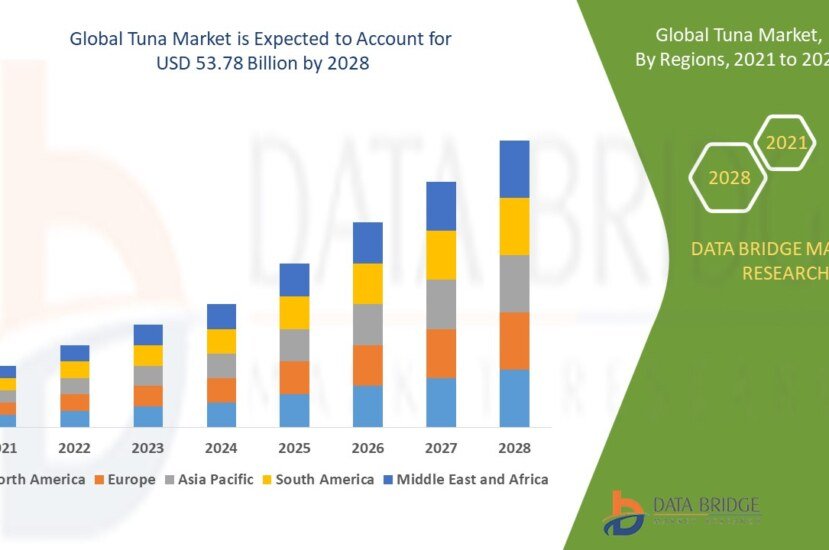Market Overview
The Tuna Market is witnessing steady expansion, driven by growing consumer demand for protein-rich seafood, increasing global trade of canned and frozen tuna, and heightened focus on sustainable fishing practices. Tuna has become a staple in diets worldwide due to its nutritional value, versatility in cooking, and long shelf life when processed. The market is being shaped by the dual forces of rising consumption in emerging economies and stringent sustainability regulations in developed regions.
According to recent market insights, the global tuna market size is expected to grow significantly between 2025 and 2032, registering a healthy CAGR. The increasing preference for ready-to-eat seafood products, particularly canned tuna, has been a major contributor to this growth. At the same time, the market is being influenced by global efforts to regulate overfishing and encourage eco-friendly tuna sourcing, creating opportunities for certified and traceable seafood producers.
Key Market Drivers
1. Rising Consumption of Protein-Rich Foods
Modern consumers are more health-conscious than ever, prioritizing protein intake for muscle development and overall wellness. Tuna, rich in omega-3 fatty acids, vitamins, and lean protein, has become a favored choice among those seeking healthier diets. The growing trend toward low-fat, high-protein foods—especially in urban centers—has made tuna a regular component in salads, sushi, sandwiches, and packaged meals.
2. Expansion of Canned and Frozen Tuna Products
Canned tuna continues to dominate the market due to its long shelf life, convenience, and affordability. Major brands are expanding their product lines with new flavors, low-sodium options, and packaging innovations. Meanwhile, the frozen tuna segment is gaining traction among restaurants and retailers catering to premium seafood consumers. The development of value-added tuna products, such as tuna fillets, steaks, and ready-to-cook meals, is further expanding market potential.
3. Sustainability and Certification Initiatives
Sustainability has emerged as a defining factor in the global tuna trade. Organizations like the Marine Stewardship Council (MSC) and International Seafood Sustainability Foundation (ISSF) are working with industry players to promote sustainable fishing practices and certification programs. Consumers are increasingly willing to pay a premium for tuna labeled as sustainably sourced. Retailers, too, are adopting sustainability standards to ensure transparent supply chains and reduce ecological impact.
4. Technological Advancements in Processing and Packaging
Technological innovations are transforming the tuna industry. Advanced freezing technologies, automated canning systems, and vacuum-sealing techniques help maintain freshness while extending product shelf life. Smart labeling and blockchain-based tracking systems are being introduced to ensure traceability, enabling consumers to verify the origin and sustainability credentials of their seafood.
Market Challenges
1. Overfishing and Environmental Concerns
One of the primary challenges facing the tuna industry is overfishing. Certain tuna species, such as bluefin and bigeye, are under pressure due to excessive harvesting. Regulatory authorities and international fishing commissions have imposed catch limits to ensure long-term resource sustainability. However, illegal, unreported, and unregulated (IUU) fishing continues to threaten tuna populations, posing risks to both the environment and legitimate market players.
2. Price Volatility
Tuna prices are influenced by fluctuating fuel costs, changing fishing conditions, and variable supply-demand dynamics. Periodic El Niño events, for instance, can disrupt ocean temperatures and tuna migration patterns, affecting catch rates. Additionally, global inflation and transportation costs have led to pricing pressures for processors and distributors.
3. Trade and Regulatory Barriers
The tuna market operates within a complex web of international trade regulations. Tariffs, import restrictions, and regional fishing quotas often pose challenges for exporters. Stringent food safety and labeling standards, particularly in the European Union and North America, demand continuous compliance and traceability documentation.
Market Segmentation
By Species
Skipjack Tuna: Dominates the global market due to its abundance and lower cost; widely used in canned tuna products.
Yellowfin Tuna: Popular for fresh and frozen segments; preferred in restaurants and high-end food chains.
Bigeye and Bluefin Tuna: Valued for their premium quality, mainly used in sushi and sashimi; limited by strict catch regulations.
Albacore Tuna: Known for its mild flavor and lighter color; often marketed as “white meat tuna.”
By Product Type
Canned Tuna (chunks, flakes, solid pack)
Frozen Tuna (steaks, fillets, whole loins)
Fresh Tuna (used primarily in restaurants and retail fish markets)
Value-Added Products (smoked tuna, tuna salad kits, tuna jerky)
By Distribution Channel
Supermarkets & Hypermarkets
Online Retail
Convenience Stores
Foodservice & Restaurants
By End User
Households (retail consumers)
Commercial (hotels, restaurants, catering, and institutional buyers)
Regional Insights
Asia Pacific
Asia Pacific dominates the global tuna market, both as a producer and consumer. Countries like Thailand, Indonesia, the Philippines, and Japan are major hubs for tuna processing and export. Thailand, in particular, leads in canned tuna production, supplying major global brands. The increasing consumption of tuna-based ready meals in urban centers across China and India also supports regional growth.
Europe
Europe represents a strong consumer market, with nations such as Spain, Italy, and the UK driving demand. The region’s emphasis on sustainable seafood sourcing and traceable supply chains has pushed companies to adopt MSC-certified tuna. European retailers are leading the charge in offering eco-labeled and responsibly sourced products.
North America
The United States remains a key market for both canned and fresh tuna. The popularity of tuna sandwiches, salads, and sushi has kept demand robust. Consumers are increasingly opting for low-mercury, sustainably sourced tuna options, prompting manufacturers to highlight transparency and nutritional value.
Middle East & Africa
Emerging demand in Gulf countries and South Africa is creating new opportunities for exporters. Rising disposable incomes, expanding retail networks, and growing awareness of protein-rich diets are contributing factors.
Latin America
Countries such as Ecuador and Mexico are strengthening their roles as major tuna exporters, supported by investments in fishing fleets and processing infrastructure.
Competitive Landscape
The global tuna market is moderately consolidated, with a few multinational corporations dominating supply chains. Key players focus on product diversification, sustainability initiatives, and regional expansion to maintain a competitive edge.
Major Companies Include:
Thai Union Group PCL
Bolton Group International
Bumble Bee Foods LLC
StarKist Co.
Jealsa Rianxeira S.A.U.
Century Pacific Food, Inc.
Dongwon Industries Co. Ltd.
Strategic collaborations and mergers between fishing companies, processors, and distributors are also becoming common, aiming to improve traceability, cost efficiency, and market reach.
Get More Details:
https://www.databridgemarketresearch.com/reports/global-tuna-market
Future Outlook
The global tuna market outlook for 2025–2032 remains positive, fueled by ongoing innovation in product development, increasing adoption of sustainability certifications, and rising seafood consumption in developing economies. Technological integration in fishing, processing, and logistics will play a pivotal role in ensuring both quality and traceability. Furthermore, consumer preference for ethical and eco-conscious brands will reshape the competitive landscape, rewarding companies that balance profitability with responsibility.




Leave a comment